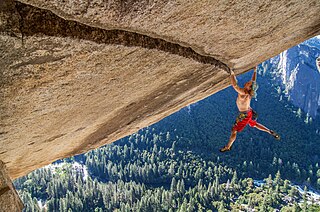
Climbing is the activity of using one's hands, feet, or other parts of the body to ascend a steep topographical object that can range from the world's tallest mountains to small boulders. Climbing is done for locomotion, sporting recreation, for competition, and is also done in trades that rely on ascension, such as construction and military operations. Climbing is done indoors and outdoors, on natural surfaces, and on artificial surfaces
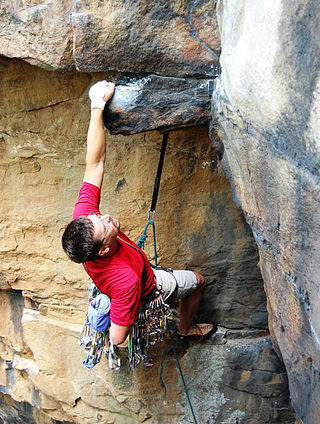
Traditional climbing is a type of free climbing in rock climbing where the lead climber places the protection equipment while ascending the route; when the lead climber has completed the route, the second climber then removes the protection equipment as they climb the route. Traditional climbing differs from sport climbing where the protection equipment is pre-drilled into the rock in the form of bolts.

Glossary of climbing terms relates to rock climbing, mountaineering, and to ice climbing.

In mountaineering and climbing, a first ascent, is the first successful documented climb to the top of a mountain or the top of a particular climbing route. Early 20th-century mountaineers and climbers focused on reaching the tops of iconic mountains and climbing routes by whatever means possible, often using considerable amounts of aid climbing, and/or with large expedition style support teams that laid "siege" to the climb.

Ice climbing is a climbing discipline that involves ascending routes consisting of frozen water. To ascend, the ice climber uses specialist equipment, particularly double ice axes and rigid crampons. To protect the route, the ice climber uses steel ice screws that require skill to employ safely and rely on the ice holding firm in any fall. Ice climbing routes can vary significantly by type, and include seasonally frozen waterfalls, high permanently frozen alpine couloirs, and large hanging icicles.

Rock-climbing equipment varies with the specific type of climbing that is undertaken. Bouldering needs the least equipment outside of climbing shoes, climbing chalk and optional crash pads. Sport climbing adds ropes, harnesses, belay devices, and quickdraws to clip into pre-drilled bolts. Traditional climbing adds the need to carry a "rack" of temporary passive and active protection devices. Multi-pitch climbing, and the related big wall climbing, adds devices to assist in ascending and descending fixed ropes. Finally, aid climbing uses unique equipment to give mechanical assistance to the climber in their upward movement.

Free climbing is a form of rock climbing in which the climber can only use climbing equipment for climbing protection but not as an artificial aid to help them in ascending the route. Free climbing, therefore, cannot use any of the tools that are used in aid climbing to help overcome the obstacles encountered while ascending a route. The development of free climbing was an important moment in the history of rock climbing, including the concept and definition of what determined a first free ascent of a route by a climber.

Solo climbing, or soloing, is a style of climbing in which the climber climbs a route alone, without the assistance of a belayer or being part of a rope team. By its very nature, solo climbing presents a higher degree of risk to the climber, and in some cases, particularly where the climber is also not using any form of climbing protection, it is considered an extremely high-risk activity.
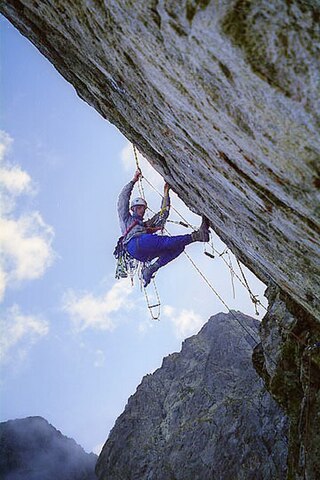
Aid climbing is a form of rock climbing that uses mechanical devices and equipment, such as aiders, for upward momentum. Aid climbing is contrasted with free climbing, which only uses mechanical equipment for protection, but not to assist in upward momentum. Aid climbing can involve hammering in permanent pitons and bolts, into which the aiders are clipped, but there is also 'clean aid climbing' which avoids any hammering, and only uses removable placements.

Sport climbing is a type of free climbing in rock climbing where the lead climber clips into pre-drilled permanent bolts for their protection while ascending a route. Sport climbing differs from the riskier traditional climbing where the lead climber has to insert temporary protection equipment while ascending.
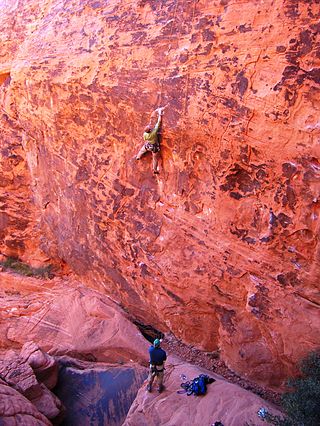
Top rope climbing is a form of rock climbing where the climber is securely attached to a climbing rope that runs through a fixed anchor at the top of the climbing route, and back down to the belayer at the base of the climb. A climber who falls will just hang from the rope at the point of the fall, and can then either resume their climb or have the belayer lower them down in a controlled manner to the base of the climb. Climbers on indoor climbing walls can use mechanical auto belay devices to top rope alone.
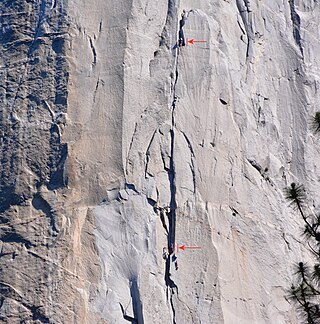
In climbing, a pitch is a section of a climbing route between two belay points, and is most commonly related to the task of lead climbing, but is also related to abseiling. Climbing on routes that require only one pitch is known as single-pitch climbing, and climbing on routes with more than one pitch is known as multi-pitch climbing.

Rock climbing is a climbing sports discipline that involves ascending routes consisting of natural rock in an outdoor environment, or on artificial resin climbing walls in a mostly indoor environment. Routes are chronicled in guidebooks, and on online databases, with the details of how to climb the route, and who made the first ascent and the coveted first free ascent. Climbers will try to ascend a route onsight, however, a climber can spend years projecting a route before they make a redpoint ascent.

Multi-pitch climbing is a type of climbing that typically takes place on routes that are more than a single rope length in height, and thus where the lead climber cannot complete the climb as a single pitch. Where the number of pitches exceeds 6–10, it can become big wall climbing, or where the pitches are in a mixed rock and ice mountain environment, it can become alpine climbing. Multi-pitch rock climbs can come in traditional, sport, and aid formats. Some have free soloed multi-pitch routes.
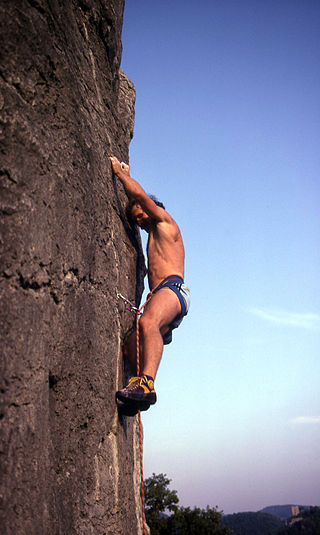
In rock climbing, redpointing means to free-climb a climbing route from the ground to the top while lead climbing, after having practiced the route or after having failed the first attempt. Climbers will try to redpoint a route after having failed to onsight it, or flash it. The first successful redpoint of a route, in the absence of any prior onsight or flash, is recorded as the first free ascent (FFA) of that route.

Competition climbing is a form of regulated rock climbing competition held indoors on purpose-built artificial climbing walls. The three competition climbing disciplines are lead climbing, bouldering, and speed climbing. The result of multiple disciplines can be used in a "combined" format to determine an all-round winner. Competition climbing is sometimes called "sport climbing", which is the name given to pre-bolted lead climbing.

Rope-solo climbing or rope-soloing is a form of solo climbing, but unlike with free solo climbing, which is also performed alone and with no climbing protection whatsoever, the rope-solo climber uses a mechanical self-belay device and rope system, which enables them to use the standard climbing protection to protect themselves in the event of a fall.

Big wall climbing is a form of rock climbing that takes place on long multi-pitch routes that normally require a full day, if not several days, to ascend. In addition, big wall routes are typically sustained and exposed, where the climbers remain suspended from the rock face, even sleeping hanging from the face, with limited options to sit down or escape unless they abseil back down the whole route, which is a complex and risky action. It is therefore a physically and mentally demanding form of climbing.

An auto belay is a mechanical device for belaying in indoor climbing walls, in both training and competition climbing formats. The device enables a climber to ascend indoor routes on a top rope but without the need for a human belaying partner. The device, which is permanently mounted in a fixed position at the top of the route, winds up a tape or steel wire to which the ascending climber is attached. When the ascending climber sits back, or falls, the auto belay automatically brakes and smoothly lowers the climber to the ground.
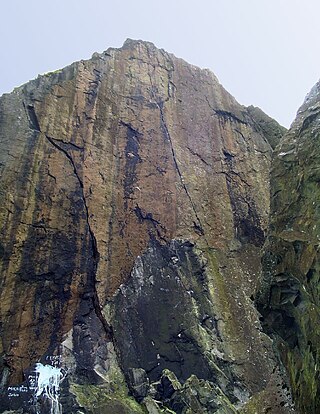
Rhapsody is a 35-metre (115 ft) long traditional climbing route up a thin crack on a slightly overhanging vertical basalt rock face on Dumbarton Rock, in Scotland. When Scottish climber Dave MacLeod made the first free ascent in 2006, it became Britain's first-ever E11-graded route, and at the grade of 5.14c (8c+), Rhapsody was the world's hardest traditional route. It set a grade milestone in traditional climbing that stood for over a decade until the ascent of Tribe at grade E11-12 5.14d (9a) in 2019 and of Bon Voyage at grade E12 5.14d (9a) in 2024.


























